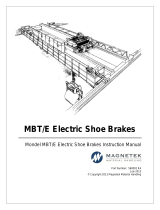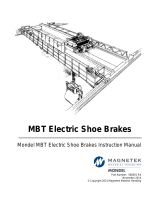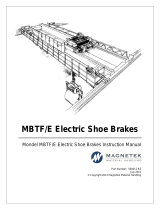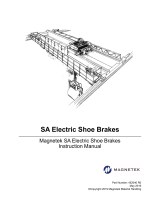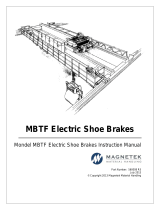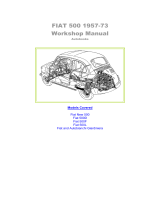Page is loading ...

300M Series, Type MBEM Electric Shoe
Brakes and MBEP Brakes
Mondel 300M Series MBEM Electric Shoe Brakes and MBEP Brakes
Instruction Manual
Part Number: 550014 R0
March 2014
© Copyright 2014 Magnetek Material Handling

March 2014 Page 2 of 37 300M Series, Type MBEM
550014 R0
SUPPLEMENTS FORMING PART OF THIS MANUAL:
DATE OF MANUFACTURE:
APPLICABLE DIMENSION PRINT:
EXPLODED VIEW:
PARTS LIST:
Installation and Maintenance
Instructions
300M Series, Type MBEM
Electric Shoe Brake

March 2014 Page 3 of 37 300M Series, Type MBEM
550014 R0
Table of Contents
Chapter 1.0: 300M, Type MBEM Electric Shoe Brakes Warnings and Cautions ............................... 4
Chapter 2.0: Description and Application ............................................................................................ 6
Chapter 3.0: Installation ...................................................................................................................... 8
Chapter 4.0: Brake Shoe and Coil Replacement .............................................................................. 10
Chapter 5.0: Complete Adjustment ................................................................................................... 16
Chapter 6.0: Releasing the Brake ..................................................................................................... 30
Chapter 7.0: Maintenance ................................................................................................................. 31
Chapter 8.0: Parts Replacement (Use Only Mondel Approved Spare Parts) ................................... 33
Chapter 9.0: Storage ......................................................................................................................... 37

March 2014 Page 4 of 37 300M Series, Type MBEM
550014 R0
Chapter 1.0: 300M, Type MBEM Electric Shoe Brake and MBEP Brake Warnings and Cautions
Read and Understand All Warnings And Cautions Printed In This Manual Before Commencing
Installation, Adjustment, Or Repair.
Anyone involved in the installation or service of this brake must have:
Received specific training.
Had experience on similar equipment.
Knowledge of the equipment on which the brake is installed.
The ability to understand the terminology.
The ability to understand the diagrams.
Do not proceed unless technically qualified for the work involved.
Chapter 3.0: INSTALLATION – Warnings and Cautions
Never lift the brake assembly by the brake rod. The brake rod will bend from the weight of the
brake, causing the linings to drag as well as damaging the rod itself.
Chapter 4.0: BRAKE SHOE AND COIL REPLACEMENT – Warnings and Cautions
Do not operate the brake unless all shoe holders are in their normal position and the holder
screws are fully into the clearance holes in the side of the shoe assembly. Damage to the brake
may result if this precaution is not strictly observed.
Disconnect and lock open power supply on crane before starting any work on the coil. Failure to
observe this warning may result in injury and/or death.
Chapter 5.0: COMPLETE ADJUSTMENT – Warnings and Cautions
Under no circumstances is it permissible to adjust the dimension below the minimum or above
the maximum dimension listed. Improper brake operation and loss of control will result, leading
to possible injury or death of personnel.
A hoist brake must be set to its rated torque, as indicated in the brake model number (e.g.,
13MBEM 550 ASCI; ‘550’ is the rated torque). This model number appears on the brake
nameplate. Failure to observe this precaution may result in damage to the brake.
The pinch point between the armature nut and base can cause personal injury. Never place
fingers or hand between the armature nut and the base. Use a tool or device to move and hold the
spacer in position.
Chapter 6.0: RELEASING THE BRAKE – Warnings and Cautions
Do not attempt to hold the spacer in place with fingers. Personal injury may result due to
pinching.

March 2014 Page 5 of 37 300M Series, Type MBEM
550014 R0
Take extra precautions to ensure that the brake coil is not energized upon completion of service.
The spacer will fall out, allowing the brake to set when the coil is de-energized. Personal injury
may result if this warning is not strictly observed.
Without fail, the nut must be returned to its original position on the armature bolt and secured
with the cotter pin. If not, it may restrict armature travel and the braking torque will be lost
without prior warning. Failure to observe this warning could lead to loss of control, possibly
resulting in personal injury.
Chapter 8.0: PARTS REPLACEMENT – Warnings and Cautions
The brake release spring will still be partially compressed when the adjusting nut comes off the
link while removing and installing a new cylinder wheel. The spring could release suddenly,
causing injury. Remove the adjusting nut slowly and very carefully.
Chapter 9.0: STORAGE – Warnings and Cautions
Data plates and labels must not be removed or painted over.

March 2014 Page 6 of 37 300M Series, Type MBEM
550014 R0
Chapter 2.0: Description and Application
DESCRIPTION
The MBEM Electric Shoe Brake is used with a manual hydraulic system, and its wheel cylinder is
designed for compatibility with commercial brake fluid. The MBEP brake is used with power-assist
systems, and its wheel cylinder is designed for compatibility with a mineral-based hydraulic oil. Both
MBEM and MBEP brakes are used to manually control the slowing and stopping of bridge and/or trolley
motions. The MBEM and MBEP brakes are spring set and electrically released. However, after being
electrically released, the brake can be hydraulically closed. The rate of deceleration is proportional to the
force applied to the foot pedal.
The MBEM and MBEP brakes are available in a number of sizes ranging from 5 inches to 19 inches. The
construction and operation, however, is the same regardless of the size of the brake (see Figure 1 on
page 7).
The MBEM and MBEP brakes combine a hydraulically set, spring-released service brake function, with a
spring-set, magnetically released parking function.
Note:
This type of brake is intended for traverse motions only, and is not for hoist motion applications.
Service brakes used for hoist applications require dynamic braking combined with a spring-set,
magnetically released motor brake.
During normal operation the magnet coil is energized, which allows the spring to hold the shoes away
from the brake wheel. Shutting the crane down, either intentionally or due to a power failure or other
malfunction, will de-energize the magnet coil, allowing the torque spring to set the brake.
With the magnet coil energized, brake operation is controlled by a foot-operated master cylinder located
in the operator’s area. Brake force is proportional to the force applied to the master cylinder foot pedal.
These brakes are designed to require a minimum of periodic maintenance. Permanently lubricated
bushings are used at all pivot points, eliminating the need for periodic lubrication. A self-adjustment
feature is also incorporated, basically consisting of a stack of spacer plates enclosed in a housing through
which the rod that connects the two brake jaws passes. As lining wear progresses, the rod moves further
through the spacer plate housing each time the brake releases. The stroke required to set the brake is
proportional to the rod movement. When the stroke length reaches a certain point, the spacer plate
nearest the brake wheel will automatically drop from the stop on the end of the brake rod. Then, the next
time the brake is set, the stop butts against the spacer that just dropped onto the rod and the brake rod
travel is shortened by an amount equal to that of the spacer. This cycle will repeat throughout the service
life of the brake linings. The spacer plates must be reset after each change in brake linings.
Note:
During heavy brake use, the brake wheel will remain hot and its diameter will remain larger than
when the wheel is cold. With the MBEM and MBEP brakes, which have a small lining clearance,
if a self-adjustment should occur during the first few brake applications while the wheel is still
cold, the thermal expansion of the wheel may reach a point where the lining clearance that
existed with a cold wheel has closed up. As such, the linings may temporarily drag lightly on the
wheel. The dragging could, in some cases, be serious enough to cause the linings to smoke
slightly. The condition described here will occur only infrequently, and will be of brief duration.
APPLICATION
These brakes are designed to operate in extremes of temperatures and duty cycles. Every brake,
however, has a specific torque rating, which is adjustable within a prescribed range. The torque rating is
dependent upon the brake size and by the type of magnet coil (shunt or series wound) which is used.

March 2014 Page 7 of 37 300M Series, Type MBEM
550014 R0
For reasons of safety, and to ensure normal service life, a brake must never be placed in an application
where the torque and energy requirements exceed the ratings of that brake.
Figure 1
Type MBEM Brake, Component Identification

March 2014 Page 8 of 37 300M Series, Type MBEM
550014 R0
Chapter 3.0: Installation
Before a brake assembly is shipped from the factory, all operating adjustments are properly made and the
brake should be ready for installation.
Note:
These brakes are shipped from the factory in the ‘released’ condition, unless equipped with the
quick-release option. Those brakes without the quick-release option have the release spacer
pinched between the nut on the armature bolt and the brake base (see Figure 9 on page 19)
holding the armature against the magnet case. The brake must remain in the released condition
to allow the shoes to clear the brake wheel during installation.
Under no circumstances should the brake be operated electrically or hydraulically unless a brake
wheel is in place between the shoes, either on a motor shaft or secured to a suitable fixture. The
release spacer will drop when the brake coil is energized, allowing the torque spring to move the
armature away from the magnet case when the coil is de-energized. Without a brake wheel in
place, an abnormally large magnet air gap will be introduced and the brake coil may not be
capable of drawing the armature magnetically.
After unpacking, make a thorough visual inspection of the brake assembly to ensure that no damage has
occurred during shipment and that there are no loose or missing parts. All self-adjustment spacers must
be hanging loosely within the housing.
The brake is designed for operation on DC power. If only AC power is available, a suitable DC power
supply will be required for brake operation.
Operating ranges of voltage and current comply with NEMA-AISE standards.
After mounting the brake wheel on the motor shaft, install the brake assembly using the following
procedure:
3.1: Reach under the self-adjustment spacer housing and make sure that all of the spacers are in the
“up” position (see Figure 2 on page 10).
3.2: Before installing the brake, check to ensure that the brake linkage is centered. To do this, lay a
rule across the shoe holder pivot bolts and note the exact dimension between the linings.
Drop a plumb bob from the center point between the linings to the centering hole in the base.
Gently tap the linkage, as necessary, to place the plumb bob directly on the centering hole.
3.3: Position the brake assembly over the brake wheel. The brake assembly must be aligned with the
motor shaft in three axes (horizontal, vertical and longitudinal), within 1/8” maximum in each
axis. Adjust the brake mounting bracket to achieve the specified vertical and longitudinal
alignment and shim under the brake base for the horizontal alignment.
3.4: When the brake assembly is properly aligned, set the linings against the brake wheel to ensure
that uniform lining contact with the wheel is attained before the mounting hardware is tightened.
This can be done electrically after connecting the brake coil. Otherwise, remove the cotter pin
from the armature bolt and back off the locknut (see Figure 17 on page 29) until the linings are in
firm contact with the wheel and the release spacer is free. The torque spring will set the brake as
the armature locknut is backed out.
3.5: Carefully check the lining contact with the wheel, along each side of both shoes. Shift the brake
assembly, if required, to obtain uniform contact.

March 2014 Page 9 of 37 300M Series, Type MBEM
550014 R0
3.6: Make sure no adjustments, previously set, were moved if an adjustment was necessary in Step
3.5. Then install and tighten the mounting hardware.
3.7: If the armature bolt locknut was turned to set the linings against the wheel in step 3.4, the locknut
must be reset to achieve proper release spacer clearance. This must be done after power is
available to the brake, as described under the topic, Brake Release Spacer Gap Adjustment.
3.8 Install the brake hydraulic control system per the instructions provided with that system. Use
caution to prevent contaminants from getting into the brake fluid or system components.
3.9 Bleed the hydraulic system to remove trapped air as instructed in the hydraulic control system’s
documentation.
3.10 Test the operation of the brake as described in the following topic, Operational Test.
OPERATIONAL TEST
Note:
Always perform an operational test of the motor brake after replacement, adjustment, or repair. If
the motor brake has erratic braking, or fails to stop and hold the traverse motion stationary, do not
attempt to operate the crane until the proper adjustments and/or repairs are performed.
Test the brakes as follows:
3.11 Operate the traverse motion and release the control lever.
3.12 Depress the brake pedal to stop traverse motion.
3.13 Repeat step 3.11.
3.14 Depress the stop pushbutton to test the brake. If the brake fails to stop and hold the motion
stationary, repair the brake as necessary. Visually inspect the brake during its operation to ensure
that it releases completely.

March 2014 Page 10 of 37 300M Series, Type MBEM
550014 R0
Chapter 4.0: Brake Shoe and Coil Replacement
Replacing the Brake Shoes (Use Only Mondel Approved Spare Parts)
Remove and install the brake shoes using the following procedure:
Note:
No adjustments, including the brake rod adjustment, need to be made during brake shoe
replacement if the procedure is performed exactly as described. However, if it is known that a
brake rod adjustment was made for some reason with anything but new linings in place, an
adjustment must be made after the new linings (shoes) are installed.
Figure 2
Opening Up Clearance for Brake Shoe Removal
HOLD
SPACERS
UP
INSIDE
LINK
4.1: Release the brake using either manual or the magnetic method, as described under the topic,
Releasing the Brake.
4.2: Reach under the adjusting spacer housing and push all of the spacer plates up against the top
cover (see Figure 2 on page 10).
4.3: Hold the spacer plates against the housing cover and gently (alternately) tap against the brake
links nearest the spacer housing with a babbit hammer (see Figure 2 on page 10).
4.4: When there is sufficient clearance between the brake wheel and the shoe assembly for a new
lining, back out the two screws in the shoe holder until the screw ends are free of the clearance
holes in the shoe (see Figure 3 on page 11).
Note:
If sufficient clearance cannot be obtained to install one (or both) new shoe assembly, a
misadjusted brake rod is the likely cause. Back the brake rod out of the pivot link an amount
necessary to allow the new shoes to be installed (see Figure 13 on page 23). Adjust the brake
rod as instructed under the topic, Brake Rod and Self-Adjusting Mechanism Adjustment.

March 2014 Page 11 of 37 300M Series, Type MBEM
550014 R0
Figure 3
Detaching Shoe Holders from Brake Shoes
SHOE
HOLDER
CLEARANCE
HOLES
4.5: Rotate the shoe holder out of the way (see Figure 4 on page 12) and remove the shoe assembly
through the side of the brake (see Figure 5 on page 13).
4.6: Slide the replacement shoe assembly into place between the holders. If necessary, tap the
assembly with a babbit hammer to achieve alignment with the far side shoe holder.

March 2014 Page 12 of 37 300M Series, Type MBEM
550014 R0
Figure 4
Rotating Shoe Holders to the Down Position
4.7: Rotate the shoe holder back into position, and tighten the two screws until they are tight against
the holder and are sticking into the clearance holes in the side of the brake shoe. If necessary,
gently tap the heads of the screws to rotate the shoe holder into alignment to allow the screws to
easily enter the clearance holes in the shoe holder.
4.8: Again, reach under the adjusting spacer housing and push any spacers, still in the down position,
up against the top cover.
4.9: Hold the spacers up, and tap gently against the insides of the links (alternately) furthest from the
spacer housing, using a babbit hammer. This will move the shoe holder with the new lining tightly
against the wheel, and move the other shoe assembly away from the wheel.
4.10: When sufficient clearance exists for a new lining between the wheel and the near side shoe
assembly, loosen the screws in one of the holders for that shoe, until they are out of the
clearance holes in the shoe.

March 2014 Page 13 of 37 300M Series, Type MBEM
550014 R0
Figure 5
Replacing Brake Shoes
4.11: Replace the shoe assembly using the procedure previously described in steps 4.5, 4.6, and 4.7.
4.12: Restore the brake to normal service as described under the topic, Releasing the Brake. The
shoes will automatically center themselves on the wheel and the correct clearance will
automatically be achieved during the first brake application.
Replacing the Coil
To replace a faulty coil, proceed as follows:
Note:
Follow appropriate Lock-Out/Tag-Out procedures.
4.13: Disconnect, lock open, and tag the mainline power disconnect which feeds the electrical power to
the brake.
4.14: Disconnect the coil leads and remove any conduit that may be present behind the area of the end
cap.
4.15: Slightly loosen the capscrews attaching the coil to the end cap. This will make the end cap
removal easier in step 4.18.

March 2014 Page 14 of 37 300M Series, Type MBEM
550014 R0
4.16: Attach a suitable lifting device to the coil and end cap and take up any slack. The lifting sling
must be around the lifting ears provided on the end cap (see Figure 6 on page 14). Do not lift at
any other point.
4.17: Remove the coil subassembly mounting screws and pull the coil and end cap from the magnet
case (see Figure 6 on page 14).
4.18: Set the assembly on the floor, or a suitable work bench, and remove the capscrews attaching the
coil to the end cap (see Figure 7 on page 15). Separate the coil and the end cap.
4.19: Assemble the new coil to the end cap and install the attaching capscrews.
4.20: Install the new assembly in the magnet case, using the hoist, and tighten the four attaching
capscrews.
4.21: Reinstall the conduit, if applicable, and reconnect the coil leads.
Figure 6
Removing Magnet Coil and End Cap
SLING
LIFTING
EARS
EN D
CAP
ADJUSTING
SCREWS
(4)
MAGNET
COIL
MAGNET
CASE

March 2014 Page 15 of 37 300M Series, Type MBEM
550014 R0
Figure 7
Removing End Cap to Coil Attaching Bolts

March 2014 Page 16 of 37 300M Series, Type MBEM
550014 R0
Chapter 5.0: Complete Adjustment
General
There are no periodic adjustments of any kind that have to be made on an MBEM or MBEP brake. A
complete series of adjustments will be required only following a major repair in which all the adjustments
were moved, or if they have been moved for any other reason. When a complete adjustment is
necessary, the individual procedures should be performed in the exact order in which they are presented
below:
5.1: Lower the load to the floor and disconnect the load from the hook if adjustments are being
performed on a hoist brake. Reset the bottom block on the floor or on a suitable support to
remove all unnecessary weight from the load line.
5.2: Adjust the torque spring as described under the topic, Torque Adjustment, or verify the previous
setting as applicable.
5.3: Check the brake release spacer gap and adjust as necessary to ensure that the spacer falls when
the brake is released. Refer to the topic, Brake Release Spacer Gap Adjustment.
5.4: Adjust the shoe holder pivot tension as described under the topic, Shoe Holder Pivot Tension
Adjustments.
5.5: Adjust the base friction bolts as described under the topic, Base Friction Bolt Adjustment.
Note:
It is essential that the base friction bolt adjustments be made before attempting to adjust the
brake rod in step 5.6.
5.6: Adjust the brake rod and self-adjusting mechanism as instructed under the topic, Brake Rod and
Self-Adjusting Mechanism Adjustments.
Note:
Do not attempt to adjust the brake rod and the self-adjustment mechanism unless the brake
linings are new. If spare shoes with new linings are available, install them temporarily on the
brake. The used linings can be reinstalled upon completion of the brake rod adjustment. The
brake will adjust to the reduced lining thickness automatically. If a brake rod adjustment must be
made with worn linings, make absolutely certain that an adjustment is performed following the
installation of the next set of new linings.
Torque Adjustment
Brake torque is a function of the compression of the large spring located beneath the coil assembly that
sets the brake. The spring compression can be varied (see the following note) over a limited range by
means of the spring adjustment bolt located in the brake base. A number of specific adjustment
dimensions and the corresponding torque values are listed on the brake nameplate, which is mounted on
the cover of the coil connection box. If the present torque setting is considered to be either too high or
too low for the particular application(s), the torque can be adjusted as outlined below:
Note:
Adjusting to any dimension (designated as ‘A’) between the smallest and the largest listed on the
nameplate is permissible. Adjustment is not limited to only those exact dimensions listed, if some
intermediate torque is desired.
5.7: Loosen the locknut on the adjusting bolt.

March 2014 Page 17 of 37 300M Series, Type MBEM
550014 R0
5.8: Turn the adjusting bolt in or out to achieve the desired dimension ‘A’ (see Figure 8 on page 18).
Turning the bolt clockwise increases the torque and turning the adjusting bolt counter-clockwise
decreases the torque.
5.9: When the desired setting is obtained, hold the adjusting bolt and tighten the locknut against the
brake base.

March 2014 Page 18 of 37 300M Series, Type MBEM
550014 R0
Figure 8
Brake Torque Adjustment
ADJUSTING
BOLT
LOCK
NUT
“A”
BRAKE DIM. A. TORQUE BRAKE DIM. A. TORQUE
SIZE (LB/FT) SIZE (LB/FT)
5 IN. 1-1/4" 16 *19 IN. 2-1/8" 800
1" 30 1-3/4" 1275
13/16" 40 1-7/16" 1750
8 IN. 1-7/8" 40 1-1/4" 2000
1-3/8" 75 **19 IN. 2-1/8" 2000
1" 100 1-15/16" 2325
11/16" 120 1-3/4" 2650
10 IN. 1-7/8" 80
1-3/8" 165
1-1/8" 200
7/8" 240
13 IN. 2-1/8" 220
1-5/8" 430
1-3/8" 550
1-1/8" 660
16 IN. 2-1/8" 400
1-5/8" 770
1-1/4" 1000
1" 1200
* With Standard Spring and Coil
** With Optional Spring and Coil

March 2014 Page 19 of 37 300M Series, Type MBEM
550014 R0
Brake Release Spacer Gap Adjustment
If the nut on the armature bolt has been moved, the spacer gap must be adjusted as follows:
5.10: If this is a hoist brake, lower the load and/or bottom block to the floor.
5.11: Energize the brake coil to close the gap between the magnet case and the armature (brake
released).
5.12: Lift the spacer up so its thick portion is directly between the nut on the armature bolt and the base
(see Figure 9 on page 19). Remove the cotter pin and turn the nut in until it is finger-tight against
the spacer, pinching the spacer against the brake base.
5.13: Back the nut off just enough so the spacer falls freely. Continue loosening the nut until the
nearest slot aligns with the hole through the armature bolt. Insert a cotter pin to lock the nut in
position.
5.14: To check the adjustment, slide the spacer up using a suitable tool and hold it in place. De-
energize the magnet and then release the spacer. The thick end of the spacer should now be
pinched between the nut and the base, and there should be little or no gap between the magnet
case and the armature. Energize the magnet. The spacer should fall freely to the lower position.
Figure 9
Brake Release Spacer in Released Position
ARMATURE
BOLT
NUT
SPACER

March 2014 Page 20 of 37 300M Series, Type MBEM
550014 R0
Shoe Holder Pivot Tension Adjustments
Provisions are made to adjust the tension at the pivot points of all four shoe holders. The shoe holders
nearest the armature are equipped with a pivot shaft, which has a nut at each end (see Figure 10 on page
20). The other shoe holders are attached at their pivot points by a bolt and nut (see Figure 11 on page
21). Separate procedures are outlined below for each shoe holder:
Note:
At all shoe holder pivot points, the Belleville spring washers must be assembled with the outer
rims against the flat washers and the inner rims against the nuts.
5.15: If this is a hoist brake, lower the load and/or bottom block to the floor.
5.16: Adjust the shoe holders nearest the armature using the following procedure (see Figure 10 on
page 20):
5.16.(a): Tighten the hex nuts on each end of the pivot to pull the parts together. The pivot shaft
must extend an equal amount beyond the nuts on both ends, to ensure that the shoulder of the
pivot shaft remains within the hole in the link.
5.16.(b): Loosen both nuts an equal number of turns until completely loose.
5.16.(c): Tighten one nut, finger-tight. Then tighten it an additional 1/6 of a turn (60) plus an
amount necessary to align a slot in the nut with a hole in the shaft. Install the cotter pin to lock
the nut into position.
5.16.(d): Tighten the other nut, finger-tight and then tighten it an additional 1/3 of a turn (120).
Either loosen or tighten the nut to align the nearest slot in the hole through the pivot shaft. Insert
a cotter pin to lock the nut in position.
Figure 10
Shoe Holder Pivot and Adjusting Nuts
ADJUSTING
NUTS
PI V OT
SH AF T
SHOE
HOLDERS
/

